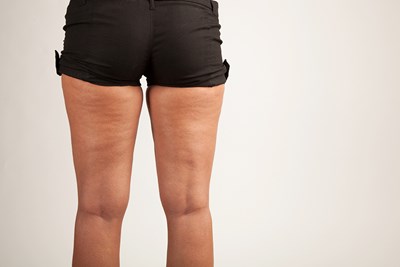Cellulite is known by many names, both scientific and unsightly, but in the end it is a pocket of fat. In men who have thicker skin, excess fat is more commonly carried on the abdomen, which makes theirs generally less noticeable. Women, on the other hand, carry excess fat in the hips and thighs and have thinner skin, making it more noticeable, and often more embarrassing. Here’s a look into the causes, risk factors, and treatments.
Symptoms
Cellulite isn’t dangerous or deadly; although obesity can pose serious health risks, cellulite can occur even on those who are in their targeted weight range. The extra fat that forms under the skin lies on top of a strong muscle system, especially on thighs and hips. These muscles are used frequently, and that pushes the fat upward, while the skin stretched over it is being pulled back downward by connective tissue. Thus, “cottage cheese skin” begins to form. Additionally, there are three medical grades of cellulite, ranging from barely visible but microscopically detectable to obvious physical signs and indentations, including paler, rough skin.
Causes
Exactly why some people seem more prone to cellulite than others is still in question. Several potential theories have been put forward, however. Women tend to develop cellulite more often than men, about 90% of women, in fact, and this is suspected to be largely hormonal. Estrogen and evolutionary changes have made women develop fat more easily (so that they can better bear and feed infants), and a series of other hormones play a role in fat development. Other suspect causes may be genes that make an individual more likely to develop cellulite sites.
Risk Factors
The only cause that can be pinpointed most certainly is diet and exercise. Those who eat poorly and lead a more sedentary lifestyle are more likely to gain more weight, which is more likely to appear as cellulite. Cigarette smokers may be at an increased risk as well. Pregnancy may make women even more likely to develop adiposis edematosa (another of cellulite's many names), probably because of hormones and the weight gain that often comes with pregnancy. Wearing clothes that are exceptionally tight around the hips, cutting off blood flow, may also increase the chances.
Treatment
Getting rid of cellulite has created a whole market of products aimed at the embarrassed consumer who is desperate to look good in their swimsuit or short skirt. Creams, special massages, body wraps, and all manner of items are produced. But very few are actually effective—in fact, none are scientifically proven. If one does work, it will probably be a very short-term effect. The only thing that’s proven to be effective is good diet and exercise.



